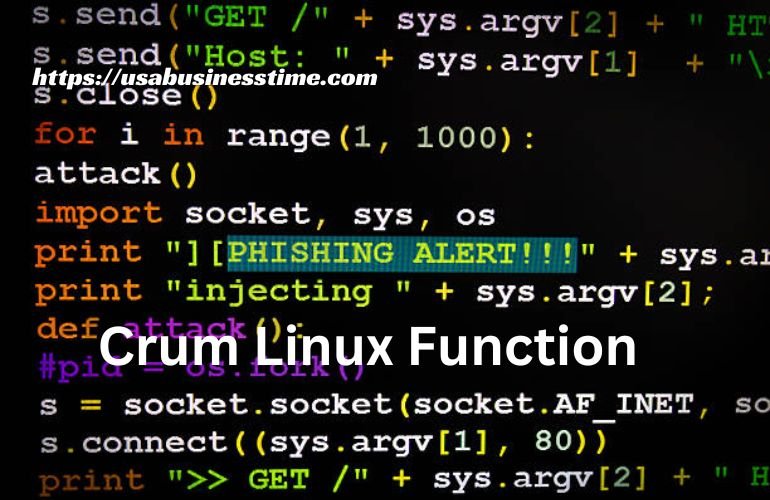Task scheduling is a key aspect of managing Linux systems effectively. Among the various methods available, the Crum Linux function stands out for its simplicity and efficiency. This function allows users to automate repetitive tasks, saving time and reducing manual effort. Whether you are managing a server or just automating daily scripts, understanding how to use the Crum function can streamline your processes.
Table of Contents
Understanding Task Scheduling in Linux
Task scheduling in Linux is a fundamental practice that allows users to automate tasks at specified intervals. The cron system is the most common tool for scheduling jobs, offering flexibility and efficiency. It runs in the background, checking every minute for scheduled tasks, known as cron jobs.
1. The Cron System
Cron is a daemon that executes scheduled commands at predetermined times. Users can define tasks in a configuration file called a crontab. Each line in the crontab represents a task and specifies when to execute it.
2. Crontab Syntax
The syntax for a cron job consists of five time and date fields followed by the command to run. The fields are:
- Minute (0-59)
- Hour (0-23)
- Day of the Month (1-31)
- Month (1-12)
- Day of the Week (0-7) where both 0 and 7 represent Sunday
For example, a cron job that runs a script every day at 3 AM would look like this:
javascriptCopy code0 3 * * * /path/to/script.sh
3. Scheduling Tasks with Cron
Cron jobs can be scheduled for various frequencies, including:
- Every minute
- Daily
- Weekly
- Monthly
- At specific intervals (e.g., every 5 minutes)
Using special characters like * (every) and / (increment), users can create complex schedules. For instance, */5 * * * * runs a job every 5 minutes.
4. Examples of Cron Jobs
Here are a few common examples of cron jobs:
- Backup a directory every day at midnight:bashCopy code
0 0 * * * rsync -a /source/directory /backup/directory - Run a script every hour:javascriptCopy code
0 * * * * /path/to/your_script.sh - Clear temporary files every Sunday at 2 AM:bashCopy code
0 2 * * 0 rm -rf /tmp/*
5. Managing Crontab
Users can manage their cron jobs using the crontab command. To view the current user’s crontab, use:
Copy codecrontab -l
To edit the crontab, the command is:
Copy codecrontab -e
This command opens the crontab in a text editor, allowing users to add, modify, or delete jobs.
How the Crum Linux Function Works
The Crum Linux function is designed to enhance task scheduling capabilities beyond traditional methods. It provides a framework for managing scheduled tasks with greater flexibility and control. Understanding how this function operates is essential for anyone looking to streamline their workflow.

1. Overview of the Crum Function
The Crum function builds upon the basic principles of the cron system, incorporating additional features that simplify the scheduling process. It allows users to set up jobs with specific conditions, enabling more complex task management.
2. Key Features of the Crum Function
- Enhanced Scheduling Options: Unlike standard cron jobs, the Crum function allows for more granular scheduling. Users can define conditions such as task dependencies and execution frequency.
- Error Handling: The Crum function includes built-in error handling mechanisms, allowing users to specify actions if a scheduled task fails. This feature helps maintain system stability and reliability.
- Logging Capabilities: The function automatically logs task executions and their outcomes. This feature aids in monitoring and troubleshooting, providing valuable insights into system operations.
3. How to Use the Crum Function
Using the Crum function involves a straightforward process:
- Installation: First, ensure that the Crum function is installed on your system. This may require adding a repository or downloading a package, depending on your Linux distribution.
- Configuration: After installation, configuration is necessary. This usually involves editing a configuration file where you can define your tasks, scheduling rules, and conditions.
- Defining Tasks: Each task can be defined with parameters such as the command to run, timing specifications, and any error-handling actions.
4. Scheduling Syntax
The syntax for scheduling tasks with the Crum function may differ slightly from traditional cron. Here is a basic example of how to define a job:
bashCopy codeCrum JobName {
command: /path/to/script.sh
schedule: "0 3 * * *"
onError: "send alert"
}
In this example, the task runs daily at 3 AM, and if it fails, an alert is sent.
5. Monitoring and Logging
The Crum function offers robust monitoring tools. Users can check logs to see the status of each scheduled task, including successful executions and errors. This logging feature helps in maintaining operational oversight and allows for quick troubleshooting if issues arise.
6. Practical Use Cases
The Crum function can be applied in various scenarios:
- Automated Backups: Schedule regular backups of databases or critical files, with alerts configured for any failures.
- Report Generation: Automate the generation of reports, ensuring they are created and delivered at specified intervals without manual intervention.
- System Maintenance: Schedule routine maintenance tasks such as cleaning temporary files or updating software packages.
Setting Up the Crum Function for Task Scheduling
Setting up the Crum function for task scheduling involves a series of steps to configure your environment, define tasks, and ensure everything runs smoothly. Here’s how to get started:
1. Installation of the Crum Function
Before using the Crum function, it must be installed on your system. Depending on your Linux distribution, the installation process may vary. Typically, you can install it via package managers like apt, yum, or pacman. Here’s a general approach:
- For Debian-based systems, run:bashCopy code
sudo apt update sudo apt install crum - For Red Hat-based systems, use:bashCopy code
sudo yum install crum - For Arch-based systems, execute:bashCopy code
sudo pacman -S crum
After installation, verify that the function is active by checking its status:
bashCopy codesystemctl status crum
2. Configuration File
The Crum function relies on a configuration file to define tasks and their schedules. This file is usually located in /etc/crum.conf or a similar directory. Open this file in a text editor with appropriate permissions:
bashCopy codesudo nano /etc/crum.conf
Within this file, you can set up global options and define specific tasks.
3. Defining Tasks
Each task must be specified clearly in the configuration file. A typical task definition includes the command to be executed, its schedule, and any error handling instructions. Here’s a sample structure for defining a task:
plaintextCopy codetask_name {
command: /path/to/your_script.sh
schedule: "0 4 * * *"
onError: "notify admin"
}
In this example, task_name is a placeholder for the name you assign to the task, the command specifies what will run, and schedule determines when it will execute. The onError directive sets up a response if the task fails.
4. Scheduling Syntax
The scheduling format for the Crum function may include more advanced options compared to traditional cron. Here are some elements to keep in mind:
- Timing Expressions: Similar to cron, you can use minute, hour, day, month, and weekday fields.
- Advanced Scheduling: Conditions can be set to run tasks only under specific circumstances, allowing for more flexibility.
5. Testing Your Configuration
Before relying on the tasks to run automatically, it is a good practice to test your configuration. You can use the following command to check for syntax errors:
bashCopy codecrum validate /etc/crum.conf
This command will provide feedback on any issues in the configuration file.
6. Starting the Crum Function
After configuring your tasks, start the Crum service to begin processing scheduled jobs:
bashCopy codesudo systemctl start crum
You can also enable it to start on boot:
bashCopy codesudo systemctl enable crum
7. Monitoring Task Execution
Once your tasks are set up, monitoring their execution is important for maintaining reliability. The Crum function typically logs task executions in a designated log file, often found in /var/log/crum.log. Check this file to see the status of your tasks and any errors that may have occurred.
You can view the log with:
bashCopy codetail -f /var/log/crum.log
8. Adjusting Tasks
As your needs change, you may need to adjust or add new tasks. Simply edit the configuration file and restart the Crum service to apply changes:
bashCopy codesudo systemctl restart crum
Practical Applications of the Crum Function
The Crum function provides a powerful means of scheduling tasks in various environments. Its versatility allows users to implement it across different scenarios, enhancing productivity and efficiency. Below are some practical applications that showcase the capabilities of the Crum function.
1. Automated Backups
One of the most common applications of the Crum function is automating backups. Regularly backing up important files and databases is essential for data protection. Using the Crum function, users can schedule tasks that create backups at specified intervals, ensuring that data is always preserved without manual intervention.
For example, to back up a database daily at 2 AM, a task can be set up as follows:
plaintextCopy codebackup_db {
command: /usr/bin/mysqldump -u user -p password database > /backup/db_backup.sql
schedule: "0 2 * * *"
onError: "send alert to admin"
}
2. System Maintenance Tasks
Maintaining system health is crucial for optimal performance. The Crum function allows users to schedule regular maintenance tasks, such as cleaning temporary files, updating packages, or checking system logs.
A sample task to clean temporary files weekly might look like this:
plaintextCopy codeclean_temp {
command: rm -rf /tmp/*
schedule: "0 3 * * 0"
}
This command runs every Sunday at 3 AM, ensuring that temporary files do not accumulate over time.
3. Report Generation
Businesses often rely on periodic reports for analysis and decision-making. The Crum function can automate the generation of these reports, running scripts that compile data and send it to stakeholders.
For instance, a task to generate a sales report daily at midnight can be defined as follows:
plaintextCopy codegenerate_sales_report {
command: /path/to/report_script.sh
schedule: "0 0 * * *"
}
4. Email Notifications
The Crum function can also be used to send automated email notifications based on certain triggers. For example, if a particular task fails or if certain conditions are met, a notification can be sent to the system administrator.
To schedule a notification task, you might configure it like this:
plaintextCopy codenotify_admin {
command: /path/to/notify_script.sh
schedule: "*/10 * * * *"
onError: "notify admin of failure"
}
This task runs every 10 minutes, checking for issues and notifying the admin if something goes wrong.
5. Data Processing Tasks
In data-driven environments, scheduling data processing tasks is essential. The Crum function can automate the execution of scripts that process incoming data, perform calculations, or update databases.
For example, a task that processes log files every hour might be configured like this:
plaintextCopy codeprocess_logs {
command: /path/to/log_processing_script.sh
schedule: "0 * * * *"
}
6. Web Scraping
For businesses that rely on data from external sources, scheduling web scraping tasks can provide valuable insights. Using the Crum function, users can set up scripts that scrape websites at regular intervals, updating their databases with the latest information.
A task to scrape data every day at 6 AM can be defined as follows:
plaintextCopy codescrape_website {
command: /path/to/scrape_script.sh
schedule: "0 6 * * *"
}
7. Cleanup Tasks
In environments where temporary data is generated, setting up cleanup tasks helps manage storage space. Users can automate the deletion of outdated files or logs, reducing clutter and maintaining system organization.
For instance, a task to delete logs older than 30 days can be set as follows:
plaintextCopy codecleanup_old_logs {
command: find /var/log -type f -name "*.log" -mtime +30 -exec rm {} \;
schedule: "0 1 * * *"
}
8. Integration with Other Services
The Crum function can be integrated with other services or applications. For example, it can trigger webhooks to notify external systems or initiate processes in response to certain conditions, enhancing interconnectivity.
By scheduling tasks that interact with other systems, users can streamline workflows and improve efficiency across platforms.
Alternative Scheduling Methods in Linux
While the Crum function offers powerful features for task scheduling, Linux provides various alternatives that users can consider based on their needs. Each method has unique characteristics, making it suitable for different scenarios. Here are some of the most common alternatives to the Crum function:

1. Cron
Cron is the traditional scheduling tool in Linux, widely used for its simplicity and reliability. It allows users to run scripts and commands at specified times using the crontab file.
- Usage: Cron jobs are defined in the crontab, where users specify the timing and the command to execute.
- Advantages: Cron is straightforward to use and is installed by default on most Linux distributions. It works well for tasks that require repetitive execution without complex conditions.
2. Systemd Timers
Systemd timers are a modern alternative that integrates with the systemd initialization system. They offer more advanced features compared to cron, including dependency management and better logging.
- Usage: Systemd timers are configured through unit files, allowing users to set timers that can activate services at specific intervals.
- Advantages: Timers support a variety of triggers, such as time-based schedules or event-based activation. This feature makes them suitable for tasks that need to respond to system states or other services.
3. Anacron
Anacron is designed for environments where the system may not run continuously, such as laptops or desktops. It ensures that scheduled tasks are executed even if the system was off during the scheduled time.
- Usage: Anacron jobs are defined in a configuration file, typically found in
/etc/anacrontab. Users specify daily, weekly, or monthly tasks that Anacron will execute the next time the system is powered on. - Advantages: This tool is ideal for users who cannot rely on continuous system uptime, as it guarantees that missed tasks will run once the system is available again.
4. Fcron
Fcron is a more flexible replacement for cron and Anacron, designed to handle both periodic and one-time tasks. It allows for scheduling based on system load and provides additional options for users.
- Usage: Fcron jobs are configured in a file similar to crontab, but with enhanced syntax for defining complex schedules.
- Advantages: Fcron supports more advanced scheduling options, including conditions based on system load or specific user sessions, making it suitable for resource-intensive tasks.
5. Task Spooler
Task Spooler is a simple job scheduler that queues tasks to be run in the order they are added. It is beneficial for managing tasks that need to execute sequentially.
- Usage: Users submit tasks to the queue using the
tscommand, and Task Spooler manages their execution. - Advantages: This method is useful for tasks that cannot run concurrently, providing a straightforward way to manage job execution.
6. At Command
The at command is designed for one-time task scheduling. Users can specify commands to run at a specific time without needing to set up recurring schedules.
- Usage: To schedule a task with
at, simply runat <time>and enter the command to execute. - Advantages: This method is ideal for tasks that need to run only once, without the overhead of setting up a cron job.
7. Custom Scripts
In addition to built-in scheduling tools, users can create custom scripts that utilize the sleep command or other methods to manage task execution. For example, a script can be set to run a task every hour by incorporating a sleep loop.
- Usage: Users can write a bash script that includes a loop with sleep intervals to execute a command repeatedly.
- Advantages: Custom scripts provide ultimate flexibility and can be tailored to specific requirements, allowing users to implement unique scheduling logic.
8. Choosing the Right Method
When deciding which scheduling method to use, consider the following factors:
- Frequency of Task: For regular, repetitive tasks, cron or Systemd timers may be ideal. For one-time tasks, the
atcommand is more appropriate. - System Availability: If the system may not be running continuously, Anacron offers the assurance that missed tasks will be executed later.
- Complexity of Requirements: If advanced scheduling features are needed, such as load-based execution, Fcron or Systemd timers could be the best options.
Each scheduling method has its strengths, making it important to evaluate the specific needs of your environment. By understanding these alternatives, users can choose the most suitable tool for their task scheduling requirements. The next section will cover best practices for effectively using the Crum function and other scheduling methods.
Troubleshooting Common Issues with the Crum Function
When using the Crum function for task scheduling, users may encounter various issues that can disrupt the execution of scheduled tasks. Identifying and resolving these common problems is essential for maintaining a smooth operation. Here are some typical issues and their solutions:
1. Task Not Executing
One of the most frequent problems is a scheduled task not running as expected. This can occur for several reasons:
- Incorrect Schedule Syntax: Check the scheduling syntax in the configuration file. An incorrect format can prevent the task from triggering.
- Service Not Running: Ensure that the Crum service is active. Use the command:bashCopy code
systemctl status crumIf it is inactive, start the service with:bashCopy codesudo systemctl start crum - Permissions Issues: Verify that the script or command being executed has the necessary permissions. The user running the Crum function must have execute rights for the script.
2. Environment Variables Not Set
Tasks executed by the Crum function may fail if they rely on specific environment variables. When scripts run in the context of the scheduler, they may not inherit the same environment as the user’s shell.
- Solution: Explicitly define any required environment variables within the script itself or within the Crum task definition. For example:plaintextCopy code
task_name { command: /path/to/script.sh environment: "VAR_NAME=value" schedule: "0 3 * * *" }
3. Error Handling Not Configured
If a task fails, the Crum function might not notify the user or take corrective action unless specified.
- Solution: Implement error handling in your task definitions. This can include notifying administrators or logging the error to a file for review. For example:plaintextCopy code
onError: "echo 'Task failed' | mail -s 'Crum Task Alert' admin@example.com"
4. Logs Not Providing Information
Logs are vital for diagnosing issues, but they may not always provide clear insights into failures.
- Solution: Ensure that logging is enabled and correctly configured. Review the log file typically located at
/var/log/crum.logto check for errors or warnings related to task execution. If the log does not contain sufficient information, consider increasing the verbosity of logging or adding additional logging statements within your scripts.
5. Conflicting Tasks
Multiple tasks trying to access the same resource or file simultaneously can lead to conflicts, causing tasks to fail.
- Solution: Review your scheduled tasks and determine if there are any conflicts. Consider staggering the execution times or implementing locking mechanisms within your scripts to prevent simultaneous access to shared resources.
6. System Resource Limitations
If the system is under heavy load, scheduled tasks may not run as intended or may experience delays.
- Solution: Monitor system resource usage, including CPU, memory, and disk I/O. If resource contention is an issue, consider adjusting the timing of your tasks or optimizing the scripts to reduce their resource consumption.
7. Compatibility Issues
Sometimes, the script or command used in a task may not be compatible with the environment in which it runs, particularly if the system has undergone updates or changes.
- Solution: Test the script independently in the command line to ensure it works as expected outside of the Crum environment. Update any dependencies or libraries required by the script to ensure compatibility.
8. Lack of Notifications for Scheduled Tasks
If users do not receive notifications about task execution status, it can lead to unnoticed failures.
- Solution: Implement a notification system to alert users when tasks are completed or if errors occur. This can include sending emails or logging messages to a monitoring system.
9. Scheduling Time Zones
Misconfigured time zones can cause tasks to run at unexpected times, leading to missed executions.
- Solution: Verify that the system time and time zone are set correctly. You can check the current time zone with:bashCopy code
timedatectlAdjust the time zone if necessary.
10. Documenting Issues and Solutions
Maintaining documentation of common issues and their solutions can be beneficial for future reference.
- Solution: Create a troubleshooting guide for the Crum function, listing common problems, symptoms, and resolution steps. This resource can help users quickly resolve issues without extensive investigation.
By addressing these common issues, users can improve the reliability of their task scheduling with the Crum function. Regular monitoring and proactive troubleshooting will help maintain a well-functioning scheduling environment. The next section will explore the benefits of using the Crum function for businesses, highlighting its impact on efficiency and productivity.
Benefits of Using the Crum Function for Businesses
The Crum function offers several advantages that can enhance operational efficiency and productivity in a business environment. By automating task scheduling, organizations can streamline their processes and reduce manual workloads. Here are some of the key benefits of using the Crum function:
1. Time Savings
Automating routine tasks frees up valuable time for employees to focus on more strategic activities. By scheduling regular processes such as backups, report generation, and system maintenance, businesses can minimize the hours spent on manual operations. This leads to improved productivity and allows teams to concentrate on core tasks.
2. Increased Reliability
The Crum function enhances the reliability of task execution. Scheduled tasks run consistently as defined, reducing the risk of human error associated with manual execution. This reliability is especially important for critical processes like data backups and system updates, where failure to execute on time can lead to significant consequences.
3. Improved Resource Management
By automating scheduling, businesses can better allocate resources. The Crum function allows for the strategic timing of tasks based on system load and resource availability. For instance, running resource-intensive processes during off-peak hours minimizes impact on system performance and improves overall efficiency.
4. Enhanced Monitoring and Reporting
The built-in logging capabilities of the Crum function provide valuable insights into task execution. Businesses can monitor performance, track errors, and analyze trends over time. This data can inform decision-making and help identify areas for improvement in operations.
5. Flexibility and Scalability
The Crum function can adapt to various business needs, whether a company is a small startup or a large enterprise. As organizations grow, their scheduling requirements may evolve. The Crum function’s flexibility allows for easy modifications to tasks and schedules, accommodating changing business demands without significant reconfiguration.
6. Better Risk Management
Automating critical tasks reduces the likelihood of missed deadlines or oversights, which can lead to operational risks. The Crum function can include error handling and notification features, alerting administrators to any issues immediately. This proactive approach helps mitigate risks associated with task failures.
7. Cost Efficiency
By reducing the need for manual intervention in routine tasks, businesses can lower operational costs. Staff can allocate time to higher-value work, resulting in better use of human resources. Additionally, minimizing errors through automation can lead to cost savings by reducing the potential for costly mistakes.
8. Streamlined Compliance
Many businesses are subject to regulatory requirements that necessitate regular reporting and data management practices. The Crum function can automate these processes, ensuring that compliance tasks are completed on time and accurately. This reduces the burden on employees and helps maintain adherence to regulations.
9. Increased Employee Satisfaction
When routine tasks are automated, employees can focus on more engaging and challenging work. This shift can lead to higher job satisfaction and morale. Employees are often more motivated when they can contribute to meaningful projects rather than getting bogged down by repetitive tasks.
10. Enhanced Collaboration
Automated scheduling can facilitate better collaboration across teams. By ensuring that essential tasks are completed on time, departments can rely on accurate and up-to-date information. This reliability fosters teamwork and improves communication, as employees can trust that the scheduled processes will be executed as planned.
By integrating the Crum function into their operations, businesses can leverage these benefits to improve efficiency, reduce costs, and foster a more productive work environment. The next section will explore best practices for effectively using the Crum function and other scheduling methods to maximize these advantages.
Best Practices for Task Scheduling in Linux
Effective task scheduling in Linux, whether through the Crum function or other methods, can significantly enhance productivity and system reliability. To get the most out of scheduling tools, consider the following best practices:

1. Define Clear Objectives
Before setting up scheduled tasks, identify the specific goals you want to achieve. Whether it’s automating backups, running maintenance scripts, or generating reports, having clear objectives helps in configuring tasks that align with your business needs.
2. Use Descriptive Task Names
When defining tasks, use descriptive names that convey the purpose of the job. This practice aids in organization and helps users quickly identify tasks within the configuration files or logs. For example, instead of naming a backup task “task1,” use “daily_backup_database.”
3. Test Tasks Thoroughly
Before relying on automated tasks, thoroughly test them in a controlled environment. Running scripts manually can help catch errors and ensure that they perform as expected. This testing phase is crucial for identifying potential issues before they impact production systems.
4. Schedule During Off-Peak Hours
For resource-intensive tasks, schedule them during off-peak hours to minimize their impact on system performance. By running backups or heavy data processing during times of low activity, you can maintain overall system responsiveness.
5. Implement Error Handling
Incorporate error handling within your scheduled tasks to manage failures effectively. Specify actions to take if a task encounters an error, such as sending notifications or logging the failure details. This approach helps maintain system reliability and provides immediate awareness of issues.
6. Regularly Review Scheduled Tasks
Periodically review your scheduled tasks to assess their relevance and effectiveness. As business needs change, some tasks may become obsolete while new requirements may arise. Regular audits help ensure that your scheduling setup remains aligned with current goals.
7. Monitor Logs for Issues
Keep an eye on logs related to your scheduled tasks. Log files can provide insights into task execution, performance, and any errors encountered. Monitoring these logs regularly can help identify patterns that may indicate underlying problems.
8. Maintain Proper Documentation
Document your scheduling setup, including task definitions, schedules, and any dependencies. This documentation can serve as a valuable resource for troubleshooting and onboarding new team members, making it easier to manage and maintain the scheduling environment.
9. Utilize Comments in Configuration Files
When editing configuration files, use comments to explain the purpose of each task or any special instructions. This practice improves readability and helps others (or your future self) understand the configuration without having to decipher the code.
10. Optimize Scripts for Performance
Ensure that the scripts being executed by the scheduler are optimized for performance. Review the code for efficiency, and minimize resource usage where possible. Efficient scripts run faster and consume fewer system resources, leading to better overall performance.
11. Consider Dependencies Between Tasks
When scheduling multiple tasks, be aware of any dependencies. For instance, if one task relies on the output of another, ensure that the first task is scheduled to complete before the second one starts. Managing dependencies helps avoid failures and ensures that tasks run in the correct order.
12. Backup Configuration Files
Regularly back up your scheduling configuration files. This practice protects against accidental deletions or corruptions, allowing you to restore settings quickly if needed. Keeping a version history of these files can also help track changes over time.
13. Use Tools for Visualization
Consider using tools that provide a graphical interface for managing scheduled tasks. Visualization can simplify the process of configuring and monitoring tasks, making it easier to identify issues and optimize schedules.
14. Educate Team Members
Train relevant team members on how to manage and troubleshoot scheduled tasks. Familiarizing them with the scheduling system and best practices promotes a collaborative approach to maintaining automation in your environment.
By following these best practices, users can maximize the effectiveness of their task scheduling, reduce the likelihood of errors, and create a more efficient workflow. In the next section, the article will provide final thoughts on the significance of task scheduling and the Crum function in modern Linux environments.
Conclusion
Task scheduling is an integral part of managing Linux systems effectively, and the Crum function stands out as a powerful tool for automating this process. By allowing users to define tasks with precision and flexibility, the Crum function enhances reliability, optimizes resource use, and frees up valuable time for more critical activities. Businesses that implement the Crum function benefit from increased efficiency, improved monitoring, and streamlined operations. As organizations continue to grow and evolve, adopting best practices in task scheduling will be essential for maintaining operational effectiveness. Embracing automation through tools like the Crum function can lead to significant improvements in productivity and overall system management.











